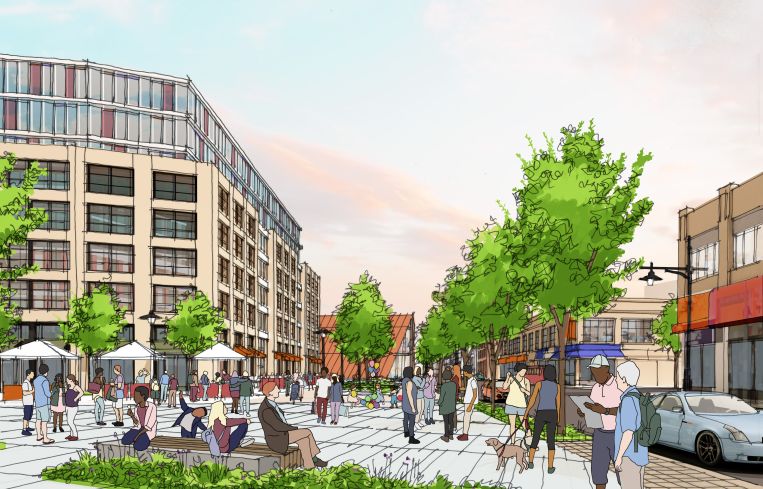How a Rezoning Promises to Reshape Downtown Far Rockaway
By Rebecca Baird-Remba September 8, 2017 7:12 pm
reprints
Yesterday, the City Council approved an ambitious, $300 million plan to rezone downtown Far Rockaway, Queens, making it the second of Mayor Bill de Blasio’s neighborhood rezonings to survive the gauntlet of public review.
The mayor’s first neighborhood rezoning, East New York, was wildly controversial and sparked intense fears of gentrification when it was passed in April 2016. Far Rockaway, on the other hand, sailed through the public review process without much fuss, clearing the City Council’s zoning subcommittee and the full council with unanimous votes.
The zoning change promises to inject $288 million worth of investment, including $128 million in city funding, into a long-blighted stretch of Far Rockaway. The city estimates that the new land use rules will pave the way for 3,100 new apartments, 165,000 square feet of retail and 81,000 square feet of community space in the 23-block rezoning area.
A big chunk of the public funding—roughly $91 million—will be used to acquire several neglected properties right around the Far Rockaway-Mott Avenue subway station. The largest and most prominent of those parcels is the Far Rockaway Shopping Center, where more than a dozen storefronts have stood empty for decades. If the city is able to acquire the shopping center and other nearby parcels on its own, 100 percent of the 1,700 apartments planned for those sites will be affordable. It might take control of the 150,000-square-foot property, which is owned by the estate of recently deceased local landlord Rita Stark, through eminent domain. However, officials hope that owners of the shopping center and the other sites will strike a deal to sell their properties to an affordable housing developer like Phipps Houses. Eminent domain will only be used as a last resort, said a spokesman for the New York City Economic Development Corporation. If a private developer, rather than the city, buys up the lots, then planners predict that only 50 percent of the planned housing will be affordable. A city-owned site nearby will also host 100 percent below-market-rate housing.
New development in the area could reach up to seven or eight stories, with the city then requiring developers to allocate at least a quarter of all new apartments as below-market rentals, as part of the mayor’s Mandatory Inclusionary Housing program.
Other pieces of the city’s plan to revamp the neighborhood include a new park, a new 30,000-square-foot public plaza, a shuttle bus from downtown to the Rockaway ferry landing at Beach 108th Street, upgrades to sewer infrastructure and sidewalks and a new public library at the corner of Mott and Central Avenues.
“Today, we begin the journey of building on the progress we have made over the past four years, by infusing hundreds of millions of dollars into infrastructure, quality jobs, parks, streetscape, transit improvements and both community facility and open space,” said local Councilmember Donovan Richards in a statement yesterday. “These investments will ensure that Far Rockaway benefits from the amenities that so many other communities in our city enjoy.”
Real estate experts who know Far Rockaway expect that the rezoning will attract plenty of new affordable development, kickstarting the real estate market.
“A lot of guys that are building in certain parts of Brooklyn, in parts of the Bronx, are going to be looking at Far Rockaway now,” said Daniel Abbondandolo, a director in the capital markets group at Cushman & Wakefield. “A lot of developers who never really thought to look in the Rockaways before now [will be interested].”
The area has been economically depressed for decades. If investors looked in the Rockaways, they typically bought in more established neighborhoods like Belle Harbor. But in recent years, developers have started purchasing and building rentals and condos in the communities to the west, like Arverne, Edgemere and Rockaway Park.
L+M Development Partners and the city’s Department of Housing Preservation and Development filed plans this week for a 119-unit affordable development at 45-19 Rockaway Beach Boulevard in Edgemere. L+M also revamped Arverne View, an 1,100-unit Mitchell Lama complex that was damaged by Superstorm Sandy.
In Far Rockaway, only one developer has taken a shot at building rentals in the past few years. JDS Development Group recently completed a 60-unit townhouse development, Saltmeadow, on the neighborhood’s more affluent eastern edge, near the border with Long Island.
However, it might be several years before new market-rate rental buildings arrive in newly rezoned stretch of downtown Far Rockaway.
“I think Far Rockaway still has some ways to go until you see market-rate development,” said Daniel Wechsler, a director of investment sales at Ariel Property Advisors. Still, the area has plenty of potential, he said, because it’s on the waterfront, and rents will be far more affordable than most parts of the city.
Wechsler pointed to Marcal Group’s planned 149-unit rental development on Beach 116th Street in Rockaway Beach as a model for future projects in the area. Since it’s a high-end rental building, he suggested that the building would be a “litmus test” for other rental projects in the area.
“I think [Far Rockaway] is an up and coming area of Queens,” he added. “The ferry there has made it easier for the workforce to get into Manhattan than the A train. And there are not so many places where you can buy land for $40 a buildable square foot anywhere in New York City. I think the sky is the limit for Far Rockaway.”


